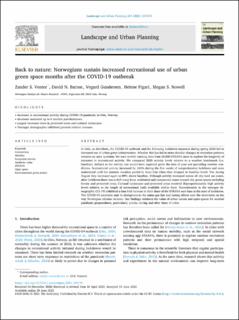| dc.contributor.author | Venter, Zander | |
| dc.contributor.author | Barton, David Nicholas | |
| dc.contributor.author | Gundersen, Vegard | |
| dc.contributor.author | Figari, Helene | |
| dc.contributor.author | Nowell, Megan Sara | |
| dc.date.accessioned | 2022-03-24T14:04:56Z | |
| dc.date.available | 2022-03-24T14:04:56Z | |
| dc.date.created | 2021-06-30T09:39:32Z | |
| dc.date.issued | 2021 | |
| dc.identifier.issn | 0169-2046 | |
| dc.identifier.uri | https://hdl.handle.net/11250/2987443 | |
| dc.description.abstract | In Oslo, as elsewhere, the COVID-19 outbreak and the following lockdown measures during spring 2020 led to increased use of urban green infrastructure. Whether this has led to more durable changes in recreation patterns remains an open question. We used mobile tracking data from 53,000 STRAVA users to explore the longevity of increases in recreational activity. We compared 2020 activity levels relative to a weather benchmark (i.e. baseline), defined as the activity one would have expected given the time of year and prevailing weather conditions. Recreational activity increased by 240% during the five weeks of comprehensive lockdown and were maintained until the summer vacation period in June/July when they dropped to baseline levels. Yet, during August they increased again to 89% above baseline. Although activity increased across all city land use zones, after lockdown there was a shift away from residential and commercial zones toward city green spaces including forests and protected areas. Cultural landscapes and protected areas received disproportionately high activity levels relative to the length of recreational trails available within them. Recreationists in the teenager demographic (13–19) exhibited a four-fold increase in their share of the STRAVA user-base at the start of lockdown. The COVID-19 pandemic and its disruptions to the status quo has had lasting effects over the short-term on the way Norwegian citizens recreate. Our findings reinforce the value of urban nature and open spaces for societal pandemic preparedness, particularly youths, during and after times of crisis. Coronavirus Mobility Ecosystem service Aesthetic value STRAVA Open space Environmental green justice | en_US |
| dc.language.iso | eng | en_US |
| dc.rights | Navngivelse 4.0 Internasjonal | * |
| dc.rights.uri | http://creativecommons.org/licenses/by/4.0/deed.no | * |
| dc.subject | Økosystemtjenester | en_US |
| dc.subject | Ecosystem services | en_US |
| dc.subject | Korona | en_US |
| dc.subject | Corona | en_US |
| dc.subject | Estetisk verdi | en_US |
| dc.subject | Aesthetic value | en_US |
| dc.title | Back to nature: Norwegians sustain increased recreational use of urban green space months after the COVID-19 outbreak | en_US |
| dc.type | Peer reviewed | en_US |
| dc.type | Journal article | en_US |
| dc.description.version | publishedVersion | en_US |
| dc.rights.holder | © 2021 The Authors | en_US |
| dc.subject.nsi | VDP::Samfunnsøkonomi: 212 | en_US |
| dc.subject.nsi | VDP::Economics: 212 | en_US |
| dc.source.volume | 214 | en_US |
| dc.source.journal | Landscape and Urban Planning | en_US |
| dc.identifier.doi | 10.1016/j.landurbplan.2021.104175 | |
| dc.identifier.cristin | 1919450 | |
| dc.relation.project | Norges forskningsråd: 160022 | en_US |
| cristin.ispublished | true | |
| cristin.fulltext | original | |
| cristin.qualitycode | 2 | |

